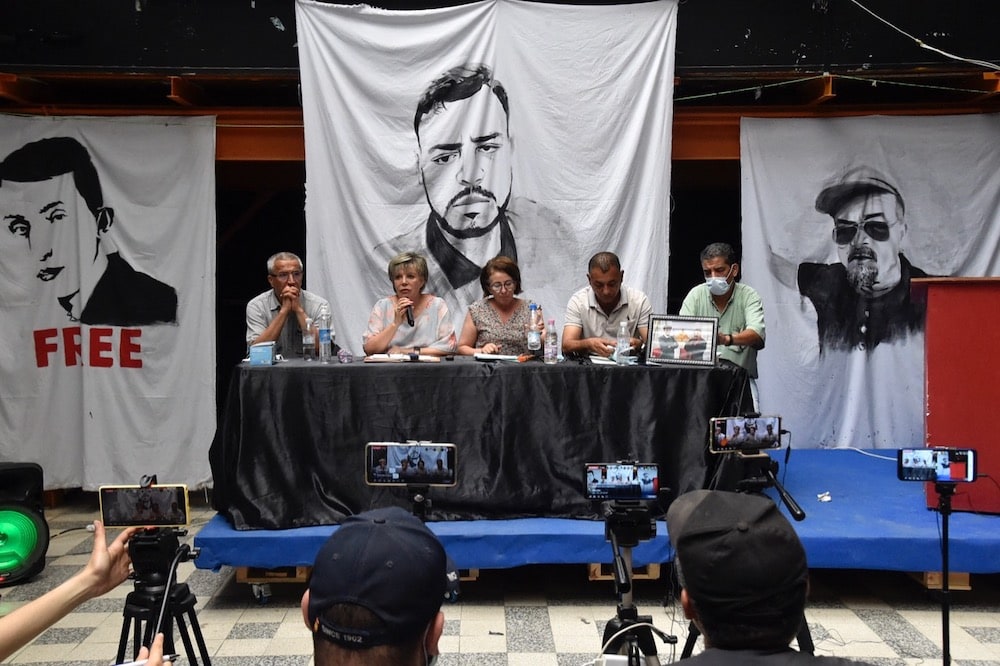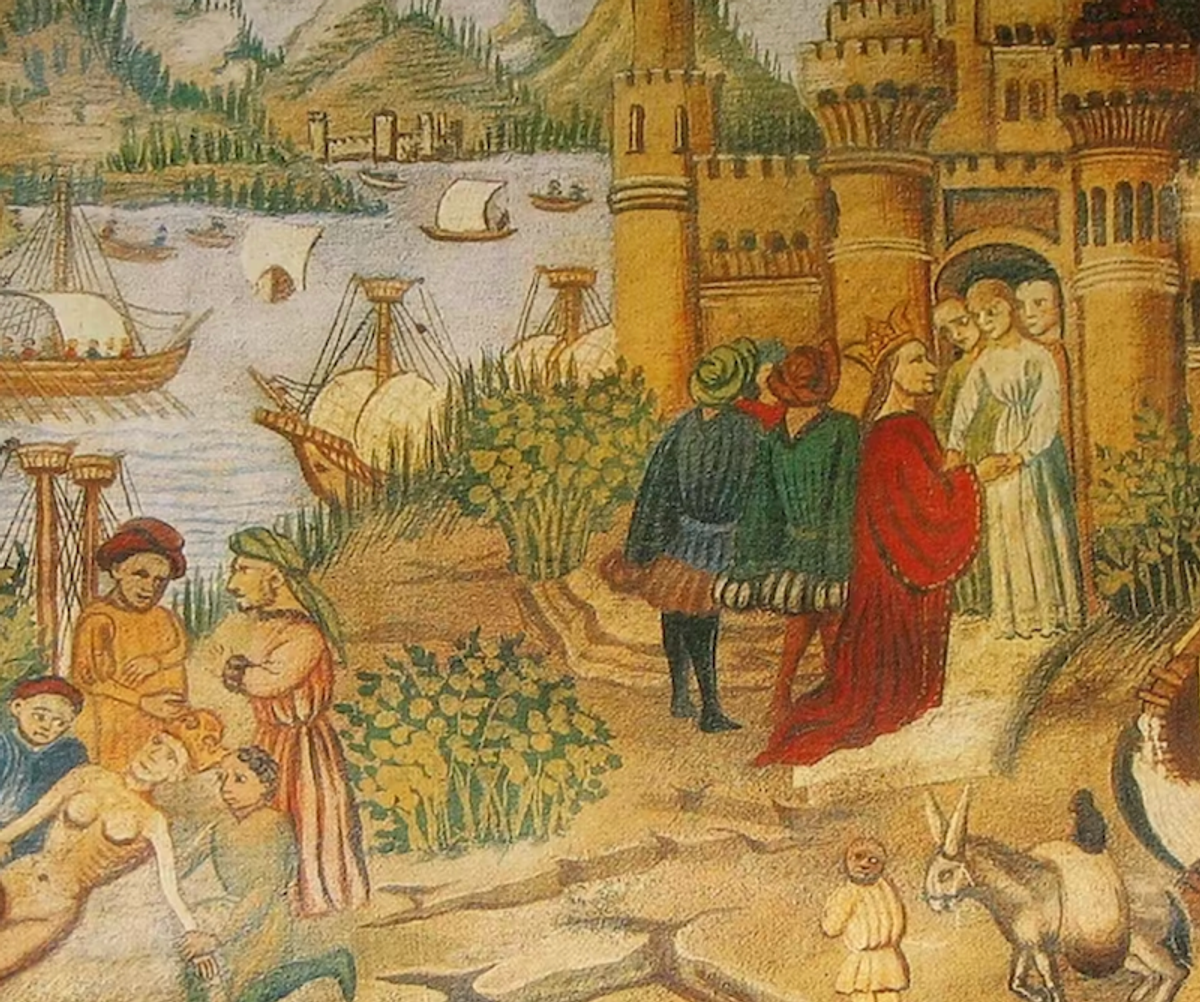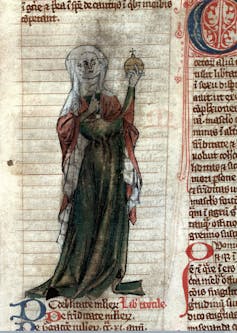Algeria|Free Expression & the Law
This page is also available in Français
Human Rights Watch
15 February 2023

A representative of the Algerian League for the Defence of Human Rights (LADDH) (second to Right), takes part in a press conference on the Hirak protest movement, in Algiers, 7 July 2021.
RYAD KRAMDI/AFP via Getty Images
"The Algerian authorities seem determined to shut down any independent activity that would shed light on human rights violations," says HRW.
This statement was originally published on hrw.org on 8 February 2023.
Authorities’ latest blow to independent civil society
Algerian authorities should reverse the decision to dissolve the Algerian League for the Defense of Human Rights (LADDH), an independent, 38-year-old group, over politically motivated allegations and allow it to operate freely and legally, Human Rights Watch and Amnesty International said today. Authorities should also end their general crackdown on independent civil society organizations and ensure they can operate in a safe and enabling environment.
The Administrative Court of Algiers dissolved the LADDH on June 29, 2022, following a complaint filed by the Interior Ministry, the organization said on January 20, 2023, after it learned of the judgment by finding it on the internet. The LADDH, which said it had been unaware of the judicial proceedings, including the complaint, is the most recent organization targeted by the authorities’ campaign to neutralize independent civil society organizations.
“The Algerian authorities seem determined to shut down any independent activity that would shed light on human rights violations,” said Eric Goldstein, deputy Middle East and North Africa director at Human Rights Watch. “In that context, it was only a matter of time before they went after the oldest and most established national human rights organization of them all.”
The six-page court judgment mentioned an initial Interior Ministry petition, dated May 4, 2022, seeking the dissolution of the League on the grounds that the LADDH had “several branches claiming its name and legal legitimacy” in breach of article 48 of Law 90-31 on Associations, issued in 1990 and pertaining to an association’s bylaws.
The reference was to past splits within the League and the law on associations in force at the time. Such splits cannot be used to justify violating the right to freedom of association by shutting down the League, Human Rights Watch and Amnesty International said. The judgment also said that the group’s “activities did not conform to its purposes” set forth in its bylaws.
The LADDH is the oldest independent human rights organization in Algeria. Founded in 1985 and officially registered in 1989, the League has continuously played a leading role in advocating for human rights and democracy. Since 2019, it took a prominent role in denouncing the crackdown on the Hirak protest movement.
On January 30, 2023, authorities closed the House of Human and Citizen’s Rights in Tizi Ouzou, an LADDH affiliate since 1990 that included a library, documentation center, and other activities. On January 23, the authorities sealed the LADDH’s Center for Documenting Human Rights (CDDH) in Bejaia, under an order by the governor of Bejaia, citing the judgment dissolving the League. The Bejaia office, among the group’s most active, organized meetings and training focused on civil rights for the public and activists. It also provided legal aid and advice on issues ranging from domestic violence to job terminations.
In its decision, the court justified the League’s dissolution by saying that it undertook “suspicious activities” such as “addressing in its publications the issue of illegal migration,” “organizing demonstrations” before courts, and “publishing documents and statements on social media accusing the authorities of repression of protests.” The court also found that the League had violated the law in failing to duly notify authorities about internal changes and activities as well as its collaboration with foreign and international organizations.
The judgment contends that the LADDH violated articles 18, 19, and 23 of the 2012 Law 12-06 on Associations. Articles 18 and 19 require associations to inform the authorities about changes in their status and in their internal organization as well as to submit annual activity and financial reports. Article 23 provides that cooperation with international and foreign associations must “respect national constants and values” and “requires prior approval of relevant authorities.”
The accusations against the group include “maintaining relations with organizations in Libya and Tunisia,” sending “reports and erroneous information to UN entities,” and meeting with the International Federation for Human Rights, Euromed Rights, and the Maghreb Coordination of Human Rights Organizations, groups the authorities deem to be “hostile to Algeria and under the influence of the Moroccan-Zionist lobby and members of the French left in the European Parliament.”
The Law on Associations of 2012 is heavily restrictive and does not conform with international standards on freedom of association. Article 2 states the objectives of an association “must fit within the general interest and not be contrary to the national foundations and values or the public order and good morals.” Such provisions are too vaguely worded to allow associations to reasonably predict whether any of their activities amount to a crime. The overly-broad and vague provisions in the law threaten the exercise of the rights to freedom of expression and of association, Amnesty International and Human Rights Watch said.
The legal provisions used to dissolve LADDH are incompatible with the right to freedom of association protected under international and African human rights laws and standards. Associations should be free to determine their statutes and activities and make decisions without government interference and should not face dissolution for their legal and peaceful activities. Civil society organizations should be free to communicate with foreign nongovernmental organizations, intergovernmental organizations, and international human rights bodies.
On December 6, 2022, the police in Bejaia prevented the city’s section of the League from hosting the 11th edition of its Human Rights Forum. Said Salhi, vice president of the LADDH said that the police informed LADDH staff members that the governor had banned the forum, including its activities.
Vicious Clampdown on Civil Society Organizations
The authorities have been cracking down on other major associations. In October 2021, a court dissolved Youth Action Rally (known by its French name, Rassemblement Action Jeunesse, or RAJ), citing noncompliance with the law and creating chaos and disturbing the public order. RAJ appealed the decision to the State Council, the country’s highest administrative court. Its verdict was postponed to February 23, 2023.
Caritas, a Catholic Church charity, announced its shutdown on September 25, 2022, after authorities criticized it for providing medical assistance and services to migrants, media reported. Founded in 1962, Caritas offered a variety of activities and charity services in Algiers.
In May 2022, the Oran governor petitioned a court to dissolve Santé Sidi Houari (SDH), an association focused on rehabilitating the cultural heritage of the city of Oran. However, the Oran administrative court ruled against the petition in December.
The cultural association SOS Bab El-Oued in Algiers suspended its activities after security forces searched its office and confiscated materials in April 2021. The president of this well-known local association, Nacer Meghnine, was sentenced to one year in prison for “harming the national interest” and “incitement to an unarmed gathering” related to the association’s activities and its members’ participation in the Hirak movement.
The right to freedom of association is guaranteed in article 22 of the International Covenant on Civil and Political Rights, and article 10 of the African Charter on Human and Peoples’ Rights, both instruments ratified by Algeria. Associations should be free to determine their bylaws and conduct activities without state interference. The United Nations Declaration on Human Rights Defenders clearly establishes the right of civil society organizations to seek, obtain and disseminate ideas and information; to advocate for human rights; to engage in governance and the conduct of public affairs; to access and communicate with international human rights bodies; and to submit proposals for policy and legislative reform at the local, national and international levels, among others.
Article 53 of Algeria’s constitution also guarantees the right to freedom of association, allowing associations to form legally on the basis of a simple declaration.
“Algeria is rapidly plunging ever deeper into a human rights crisis where there is virtually no more space for human rights work and activities,” said Amna Guellali, Amnesty International’s deputy director for the Middle East and North Africa. “The authorities’ dismantling of the oldest human rights group in the country will go down in history as a shameful act that must be reversed immediately.”
"The Algerian authorities seem determined to shut down any independent activity that would shed light on human rights violations," says HRW.
This statement was originally published on hrw.org on 8 February 2023.
Authorities’ latest blow to independent civil society
Algerian authorities should reverse the decision to dissolve the Algerian League for the Defense of Human Rights (LADDH), an independent, 38-year-old group, over politically motivated allegations and allow it to operate freely and legally, Human Rights Watch and Amnesty International said today. Authorities should also end their general crackdown on independent civil society organizations and ensure they can operate in a safe and enabling environment.
The Administrative Court of Algiers dissolved the LADDH on June 29, 2022, following a complaint filed by the Interior Ministry, the organization said on January 20, 2023, after it learned of the judgment by finding it on the internet. The LADDH, which said it had been unaware of the judicial proceedings, including the complaint, is the most recent organization targeted by the authorities’ campaign to neutralize independent civil society organizations.
“The Algerian authorities seem determined to shut down any independent activity that would shed light on human rights violations,” said Eric Goldstein, deputy Middle East and North Africa director at Human Rights Watch. “In that context, it was only a matter of time before they went after the oldest and most established national human rights organization of them all.”
The six-page court judgment mentioned an initial Interior Ministry petition, dated May 4, 2022, seeking the dissolution of the League on the grounds that the LADDH had “several branches claiming its name and legal legitimacy” in breach of article 48 of Law 90-31 on Associations, issued in 1990 and pertaining to an association’s bylaws.
The reference was to past splits within the League and the law on associations in force at the time. Such splits cannot be used to justify violating the right to freedom of association by shutting down the League, Human Rights Watch and Amnesty International said. The judgment also said that the group’s “activities did not conform to its purposes” set forth in its bylaws.
The LADDH is the oldest independent human rights organization in Algeria. Founded in 1985 and officially registered in 1989, the League has continuously played a leading role in advocating for human rights and democracy. Since 2019, it took a prominent role in denouncing the crackdown on the Hirak protest movement.
On January 30, 2023, authorities closed the House of Human and Citizen’s Rights in Tizi Ouzou, an LADDH affiliate since 1990 that included a library, documentation center, and other activities. On January 23, the authorities sealed the LADDH’s Center for Documenting Human Rights (CDDH) in Bejaia, under an order by the governor of Bejaia, citing the judgment dissolving the League. The Bejaia office, among the group’s most active, organized meetings and training focused on civil rights for the public and activists. It also provided legal aid and advice on issues ranging from domestic violence to job terminations.
In its decision, the court justified the League’s dissolution by saying that it undertook “suspicious activities” such as “addressing in its publications the issue of illegal migration,” “organizing demonstrations” before courts, and “publishing documents and statements on social media accusing the authorities of repression of protests.” The court also found that the League had violated the law in failing to duly notify authorities about internal changes and activities as well as its collaboration with foreign and international organizations.
The judgment contends that the LADDH violated articles 18, 19, and 23 of the 2012 Law 12-06 on Associations. Articles 18 and 19 require associations to inform the authorities about changes in their status and in their internal organization as well as to submit annual activity and financial reports. Article 23 provides that cooperation with international and foreign associations must “respect national constants and values” and “requires prior approval of relevant authorities.”
The accusations against the group include “maintaining relations with organizations in Libya and Tunisia,” sending “reports and erroneous information to UN entities,” and meeting with the International Federation for Human Rights, Euromed Rights, and the Maghreb Coordination of Human Rights Organizations, groups the authorities deem to be “hostile to Algeria and under the influence of the Moroccan-Zionist lobby and members of the French left in the European Parliament.”
The Law on Associations of 2012 is heavily restrictive and does not conform with international standards on freedom of association. Article 2 states the objectives of an association “must fit within the general interest and not be contrary to the national foundations and values or the public order and good morals.” Such provisions are too vaguely worded to allow associations to reasonably predict whether any of their activities amount to a crime. The overly-broad and vague provisions in the law threaten the exercise of the rights to freedom of expression and of association, Amnesty International and Human Rights Watch said.
The legal provisions used to dissolve LADDH are incompatible with the right to freedom of association protected under international and African human rights laws and standards. Associations should be free to determine their statutes and activities and make decisions without government interference and should not face dissolution for their legal and peaceful activities. Civil society organizations should be free to communicate with foreign nongovernmental organizations, intergovernmental organizations, and international human rights bodies.
On December 6, 2022, the police in Bejaia prevented the city’s section of the League from hosting the 11th edition of its Human Rights Forum. Said Salhi, vice president of the LADDH said that the police informed LADDH staff members that the governor had banned the forum, including its activities.
Vicious Clampdown on Civil Society Organizations
The authorities have been cracking down on other major associations. In October 2021, a court dissolved Youth Action Rally (known by its French name, Rassemblement Action Jeunesse, or RAJ), citing noncompliance with the law and creating chaos and disturbing the public order. RAJ appealed the decision to the State Council, the country’s highest administrative court. Its verdict was postponed to February 23, 2023.
Caritas, a Catholic Church charity, announced its shutdown on September 25, 2022, after authorities criticized it for providing medical assistance and services to migrants, media reported. Founded in 1962, Caritas offered a variety of activities and charity services in Algiers.
In May 2022, the Oran governor petitioned a court to dissolve Santé Sidi Houari (SDH), an association focused on rehabilitating the cultural heritage of the city of Oran. However, the Oran administrative court ruled against the petition in December.
The cultural association SOS Bab El-Oued in Algiers suspended its activities after security forces searched its office and confiscated materials in April 2021. The president of this well-known local association, Nacer Meghnine, was sentenced to one year in prison for “harming the national interest” and “incitement to an unarmed gathering” related to the association’s activities and its members’ participation in the Hirak movement.
The right to freedom of association is guaranteed in article 22 of the International Covenant on Civil and Political Rights, and article 10 of the African Charter on Human and Peoples’ Rights, both instruments ratified by Algeria. Associations should be free to determine their bylaws and conduct activities without state interference. The United Nations Declaration on Human Rights Defenders clearly establishes the right of civil society organizations to seek, obtain and disseminate ideas and information; to advocate for human rights; to engage in governance and the conduct of public affairs; to access and communicate with international human rights bodies; and to submit proposals for policy and legislative reform at the local, national and international levels, among others.
Article 53 of Algeria’s constitution also guarantees the right to freedom of association, allowing associations to form legally on the basis of a simple declaration.
“Algeria is rapidly plunging ever deeper into a human rights crisis where there is virtually no more space for human rights work and activities,” said Amna Guellali, Amnesty International’s deputy director for the Middle East and North Africa. “The authorities’ dismantling of the oldest human rights group in the country will go down in history as a shameful act that must be reversed immediately.”



















